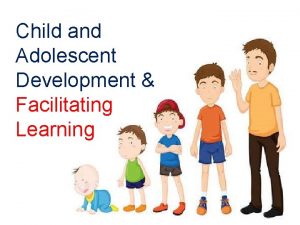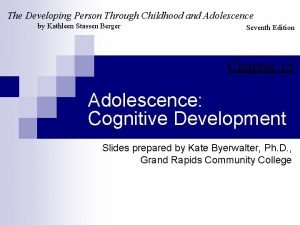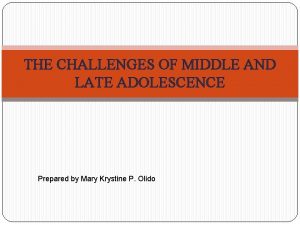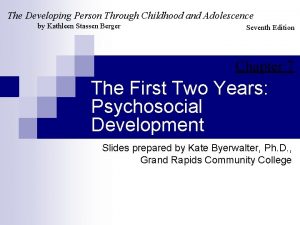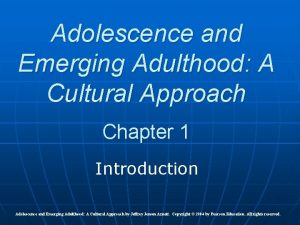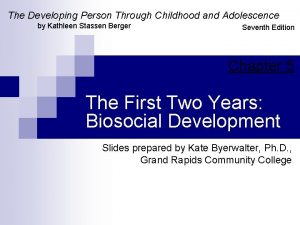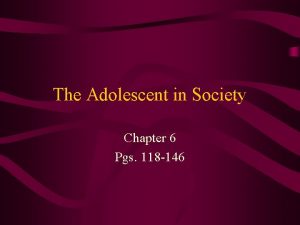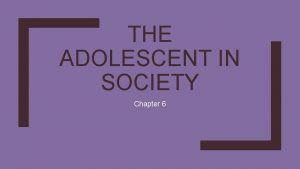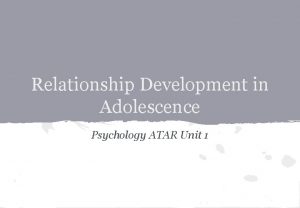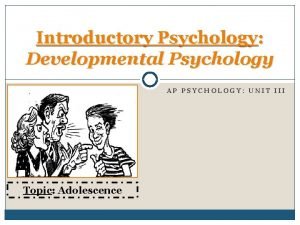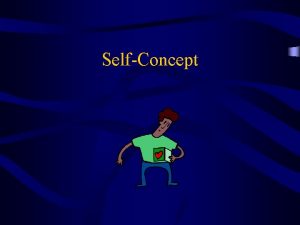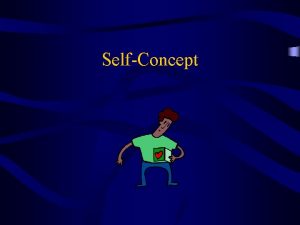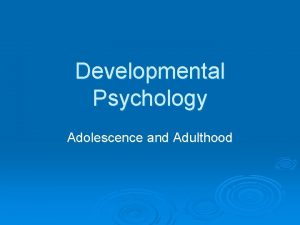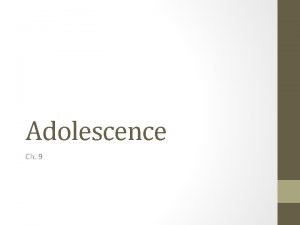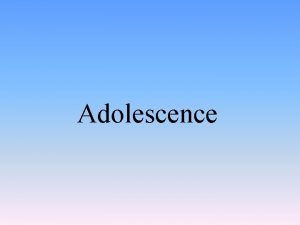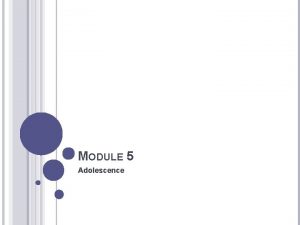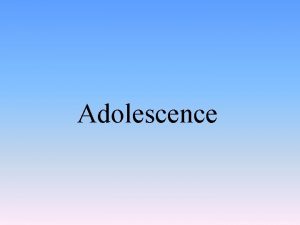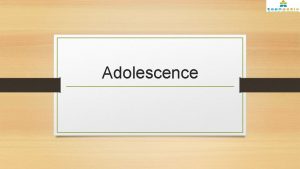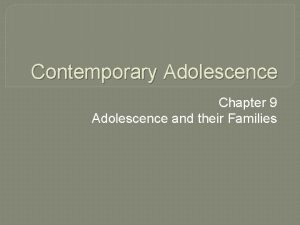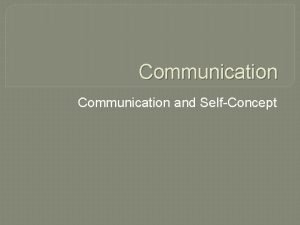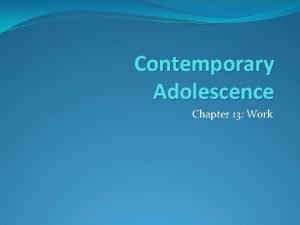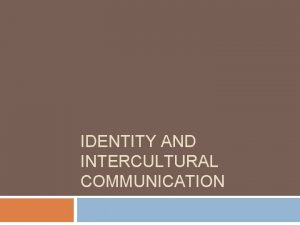Contemporary Adolescence Selfconcept and identity Selfconcept Adolescent selfconceptions
















- Slides: 16

Contemporary Adolescence Self-concept and identity

Self-concept �Adolescent self-conceptions become increasingly more abstract and complex through development �Abstract: �Actual self: a person’s perception of the self as it is �Possible self: a person’s conception of the self as it potentially may be � Ideal: the person an adolescent would like to be � Feared: The self a person imagines it is possible to become but dreads becoming �Complex: �Older adolescents recognize contradictions in their personality �False self: a self that is presented to others while realizing it doesn’t represent what they are actually thinking or feeling

Self-Concept—another perspective ity lo G l ba nt e d I Traits Competenc ies Values R Sp ole Id ec en ific tit y Traits Leonard, Beauvais, & Competenc ies Values • Traits: behavior patterns • Competencies: skills, abilities, talents, knowledge • Values: concepts and beliefs about desirable end states Level of attributes: • Level: degree to which individual perceives he/she possess attribute. Two types of evaluation: • Ordinal: compare to others • Fixed: measures against a predetermined standard • Strength: how strongly the individual holds the perception of the attribute

Self-Concept—Third perspective Time Tragic Comedy or Romanc e Happily ever after Heroic Saga Establishing a valued endpoint Selecting events relevant to the endpoint Ordering of events Stability of identity Causal linkages Demarcation signs Brown and Dawson

Self-esteem � Positive self-esteem is linked to long-term mental health and emotional well-being � Well-established link between low self-esteem and depression in adolescents � Well-established link between low self-esteem and suicide � Adolescents with low self-esteem are self-conscious and overly vulnerable to criticism or rejection � Sometimes adolescents develop a false front to hide feelings � Acceptance of self is positively correlated with acceptance from others

Self-esteem �A person’s overall sense of worth and well-being �Six components, or pillars (Branden) �Living consciously �Self-acceptance �Self-responsibility �Self-assertiveness �Living purposefully �Personal integrity

Types of self-esteem �Baseline self-esteem �Barometric self-esteem

Development of a positive selfconcept �Significant others �Parental interest, concern, and discipline �Stress �Physical disabilities �Gender �Ethnicity �Divorced and blended families

Eight domains of adolescent selfimage �Scholastic competence �Social acceptance �Athletic competence �Physical appearance �Job competence �Romantic appeal �Behavioral conduct �Close friendship Susan Harter

Identity �Seven conflicts according to Erikson: �Temporal perspective vs. time confusion �Self-certainty vs. self-consciousness �Role experimentation vs. role fixation �Apprenticeship vs. work paralysis �Sexual polarization vs. bisexual confusion �Leadership and followership vs. authority confusion �Ideological commitment vs. confusion of values

The Four Identity Statuses Commitment Exploration Yes No Yes Achievement Moratorium No Foreclosure Diffusion: Not seriously attempting to sort through potential choices and make enduring commitments Moratorium: Actively trying out different personal, occupational, and ideological possibilities Foreclosure: Seen as unhealthy. Often a result of parents’ strong influence Achievement: Preceded by a period of moratorium; definite choices regarding personal, occupational, and ideological have been made

Components of Identity �Physical �Sexual �Social �Vocational �Moral �Ideological �Psychological

Identity as a process--Burke �Interpersonal components �Social behavior �Feedback �Intrapersonal components �Self-concept �Identity standards �Comparator

Styles of Identity Searching-Berzonsky �Informational style: Seek out diagnostic information and accommodate their plans and behaviors �Normative style: Resistant to change and block out discrepant information �Avoidant style: Put off making decisions and evade feedback

Small group activity �Get in small groups �Talk about who was the greatest influence in helping to develop your identity. �When developing your identity, did you identify with anyone around you? �Who were (are) your heroes, and how did they influence you? �Were you able to experiment with identities and how did you feel safe doing so?

Ethnic Identity Identification with Ethnic Group Identification with Majority Culture High Low High Bicultural Assimilated Low Separated Marginal Bicultural: developing a dual identity, alternating between them as appropriate Assimilation: leaving behind one’s ethnic group and adopting values and way of life of the majority culture Marginality: rejecting one’s own culture, but feeling rejected by majority culture Separation: associating only with members of one’s own ethnic group and rejecting the ways of the majority culture
 Scaffold and fade-away technique
Scaffold and fade-away technique Social identity mapping
Social identity mapping Infants, children and adolescents 8th edition
Infants, children and adolescents 8th edition Adolescent egocentrism
Adolescent egocentrism The developing person through childhood 7th edition
The developing person through childhood 7th edition Challenge of middle and late adolescence
Challenge of middle and late adolescence Eating a balanced diet during childhood and adolescence
Eating a balanced diet during childhood and adolescence The developing person through childhood and adolescence
The developing person through childhood and adolescence Middle childhood years
Middle childhood years Adolescence and emerging adulthood a cultural approach
Adolescence and emerging adulthood a cultural approach The developing person through childhood and adolescence
The developing person through childhood and adolescence Pre adolescent girl
Pre adolescent girl Chapter 6 the adolescent in society
Chapter 6 the adolescent in society Chapter 6 the adolescent in society
Chapter 6 the adolescent in society The adolescent in society guided reading
The adolescent in society guided reading Dexter dunphy 5 stages
Dexter dunphy 5 stages Personal fable ap psychology
Personal fable ap psychology
